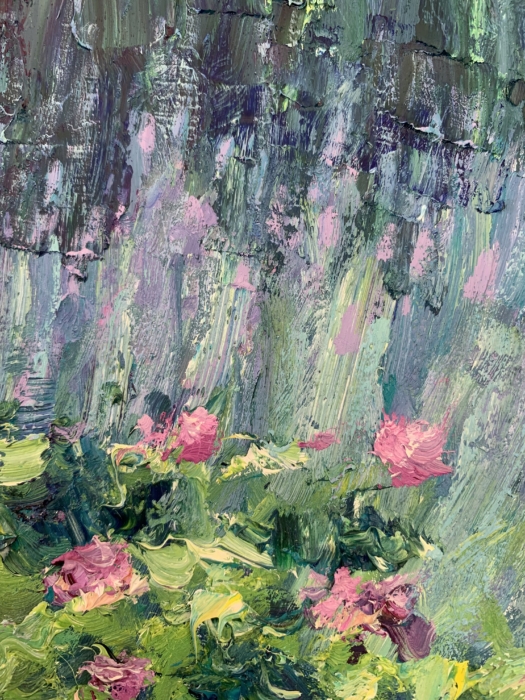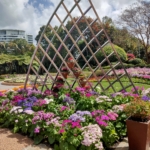This month’s report is all about garden paintings. I’ll cover:
Below is one of my most recent paintings. It depicts the garden out the front of my parents' home. I grew up with this garden. It has changed over time, but for the most part, it's the same as I always remember.
Painting a subject you are sentimental about adds an interesting dimension to the painting. There’s more emotion behind it and it brings into account the differences in perspective. The way I see the garden is different from the way you see it. To you, it’s a garden. To me, it’s part of my childhood home.
When painting sentimental subjects, don’t shy away from your feelings. Lean into them. Your job as an artist is to convey how you see the subject and the world in general. Refer to last month’s report on pushing your ideas.

Step 1: Plan
Before I start any painting, I review the reference photo and try to visualize the process. How will I start? What techniques will I use? What colors and tools? What will the finished painting look like? This is an important step in the process! The more thought that goes into the planning, the smoother the painting process. Below were some of my preliminary thoughts on this painting:
- It's a cluttered scene, so simplification would be important to make sense of it all.
- The scene can be segmented into the light area in the foreground and the dark background.
- The white, pink, and purple flowers will play an important role. For them to work, the surrounding greens will need to be right.
- The architecture needs to be accurate (mistakes in architecture tend to stand out).
- Broken color and some palette knife work will be key.

Step 2: Rough Sketch
The purpose of the sketch is to map out the general composition, the major shapes, and any critical lines and details.

Step 3: Color Block-In.
I paint the basic color shapes without worrying about highlights, dark accents, or any intricate details. This is a no-frills version of the painting.


Step 4: Refine
With the major color shapes in place, I am left to focus on the highlights, dark accents, texture, and bursts of color. There is no strict process to this. I basically pick an area and bring it to near finish, then I move on to the next area. There's a lot of back-and-forths and I try to make all the parts fit together. A key challenge of painting is that, when you make one change, all the other relationships also change. You must always be mindful of the big-picture and how the painting works as a whole.



Step 5: Finishing Touches, Sign, and Photograph
This last step is just about getting everything to work together and ironing out any cracks. Once satisfied, I sign and photograph the finished painting.


Here are some closeups of the painting. Take note of the thick texture and multicolored strokes.
- Can you use texture to reiterate key details and play into the idea of nature?
- Broken color is particularly effective for conveying the illusion of detail and activity.
- Different areas might have different goals and require different techniques. In my garden painting, I took a different approach for the stairs than for the lush plants and flowers. This contrast strengthens the painting—the stairs look more rigid and the plants and flowers look more organic and natural.
- Garden scenes tend to lack a clear focal point. You could play into this and make the painting as a whole the focus. Or you could narrow down on a few key flowers, plants, or other details.
- Gardens are full of activity and detail. Think of all the colors, textures, highlights, shadows, patterns, lines, and shapes. You must simplify in order to make sense of it all. Listen to your first impression of the scene. Where are your eyes drawn? What details command your attention? What details fall back?
Here are some garden reference photos for you to paint from:
I’ll wrap this report up with a showcase of some master garden paintings, starting with Childe Hassam's The Water Garden. Look how each area melts into the next. The flowers, the trees, the water, the ground—both distinct and part of the whole.

Edouard Manet’s The Monet Family in Their Garden at Argenteuil is an example of using simplification and technique to draw attention to certain aspects of the painting. The garden in this case takes a back-seat role to the Monet family. The garden is simple and plain. The Monet family is full of contrast and, in the case of the mother and son, light.

Claude Monet took a different approach in his Alice Hoschedé in the Garden. The garden plays a prominent role, with its sharp color, contrast, and detail. And it’s tightly woven in with the subject.

John Russell had an interesting style. A mix of Claude Monet, Vincent van Gogh, and Henri de Toulouse-Lautrec. In this painting, he took a pointillist approach for the garden, with tiny dabs of distinct color. For his wife, he used a more refined approach, with solid color shapes and rendering of light and shadow around her face and hair. Different areas, different goals.

Vincent van Gogh pushed the lines and activity in Long Grass with Butterflies. The dark accents play an important role in defining the plants and providing structure to the busy display of color. Notice all the different green tones—warm greens, cool greens, light greens, dark greens. This painting is a perfect demonstration of a limited color palette at work.

Sergey Arsenievich Vinogradov painted in a similar way to van Gogh, with strong directional brushwork that takes our eyes on a journey around the painting. The value contrast is sharp, suggesting it’s a clear, sunny day. More light=sharper contrast.

Pierre-Auguste Renoir’s wispy style and broken color work particularly well for gardens. In Woman with a Parasol in a Garden, notice how Renoir gently brings some areas forward in terms of attention and pushes other areas back. And look how vague the people are. Nothing but simple color shapes, but the context of the painting gives them meaning.

I love this painting by Renoir. The foreground is filled with contrast and color. The background is wispy and vague, with two men chatting. Notice how the men melt into the surroundings and form part of the background. This creates an interesting dynamic. Our eyes are naturally drawn towards people, especially people chatting like this. What are they chatting about? Who are they? But they are painted in a way that they are pushed back in terms of attention. My eyes end up bouncing between the background and foreground.

Happy painting!
Dan Scott
drawpaintacademy.com









































I loved the way you showcased your painting (lovely by the way) then offered several artists’ styles and approaches to garden scenes. Each so distinct.
Beautiful painting and a fanastic walk-through of your process! There is a lot to take away from this lesson. Thank you!
As I have painted a lot of gardens, and especially studying Monet and Van Gogh, your explanations and analysis are excellent, with much to consider and experiment. Thank you for these tools from master teachers; you garden is wonderful.
Looking at your painting: Garden, I feel surrounded by the warm, fragrant air, admiring the flower garden painted masterly in Renoir’s palette. I’m very fortunate to have found such a teacher, mentor, who is sharing his innermost dedication to this fine art. Thank you so much.
Thank you for finding these paintings. I really appreciate your comments about each picture. Because of your teachings I find I look at everything around me quite differently. I seem to see a lot of aspects of my “ordinary” life as pictures…yet to be painted !!! Thank you.
This was another wonderful lesson – a step by step look into your process. I love it and am looking forward to trying it for myself – these images have me looking at things, as I walk the dogs and everything is starting to bloom here, very differently. I feel as if I have new eyes!
Thank you again for showing the many artists’ paintings on what to focus on and your step by step to guide one through a garden painting. Cant wait to try my garden.
Your painting is beautiful. It is such a difficult composition. I love the master paintings you have chosen. I sought Monet never painted Alice. I love best the Renoir painting with the chat by the fence.
My next painting will be olive trees in the Aegina garden.
I am about to take my first try at painting flowers. This was very helpful. Thank you. Kim